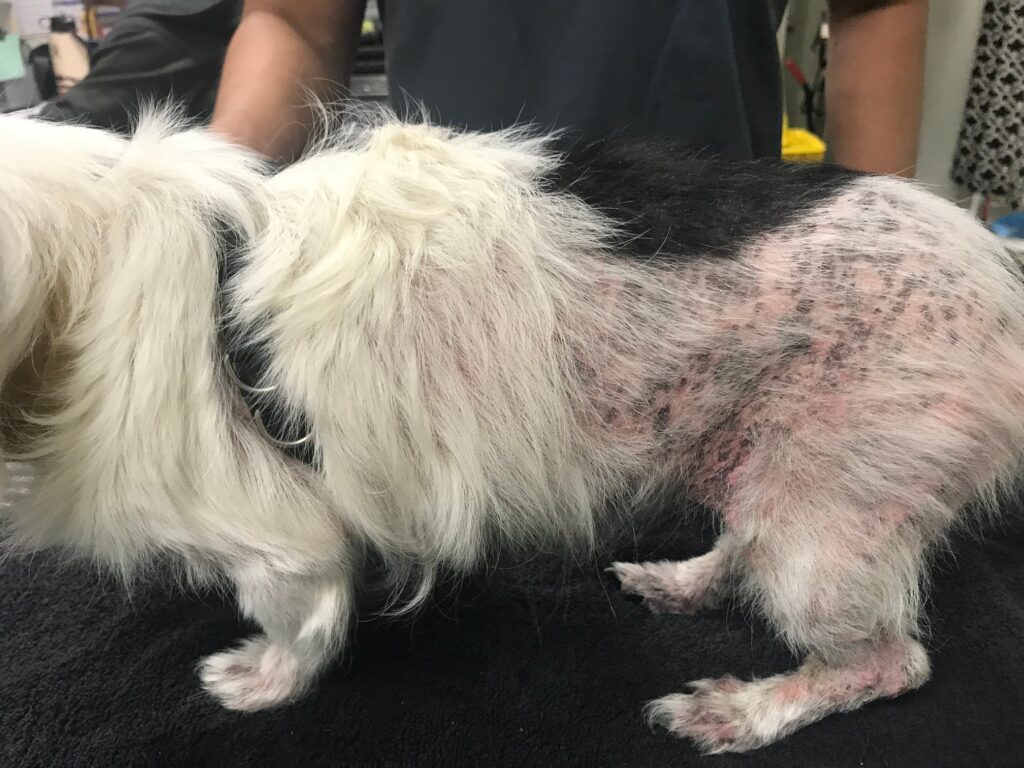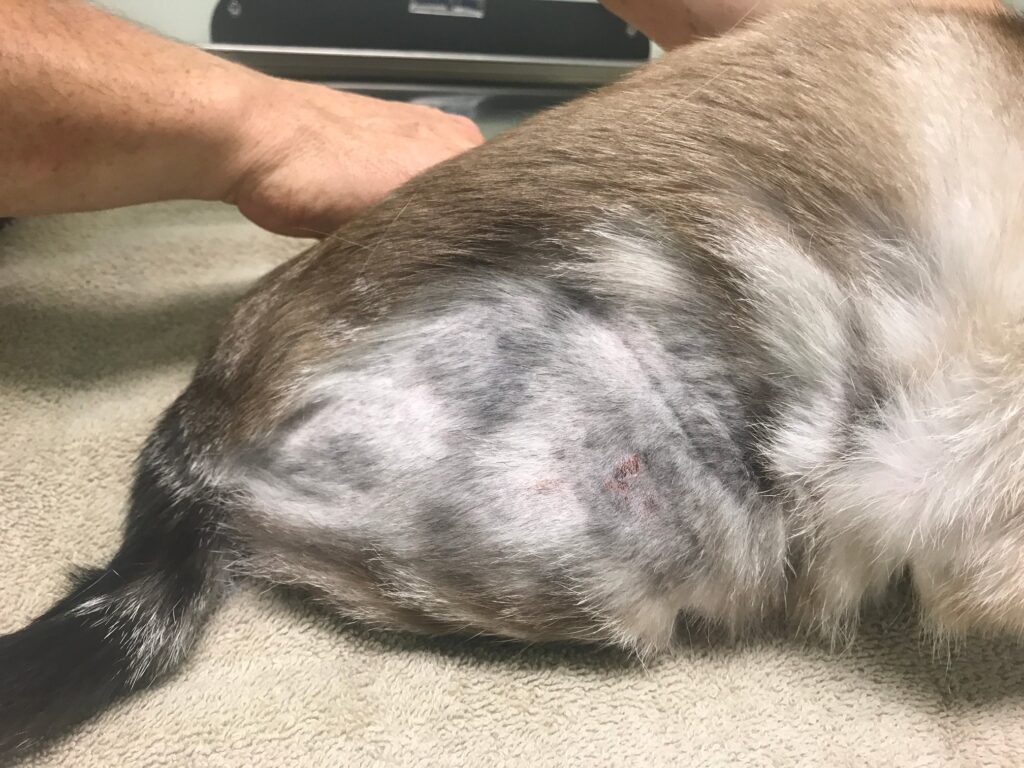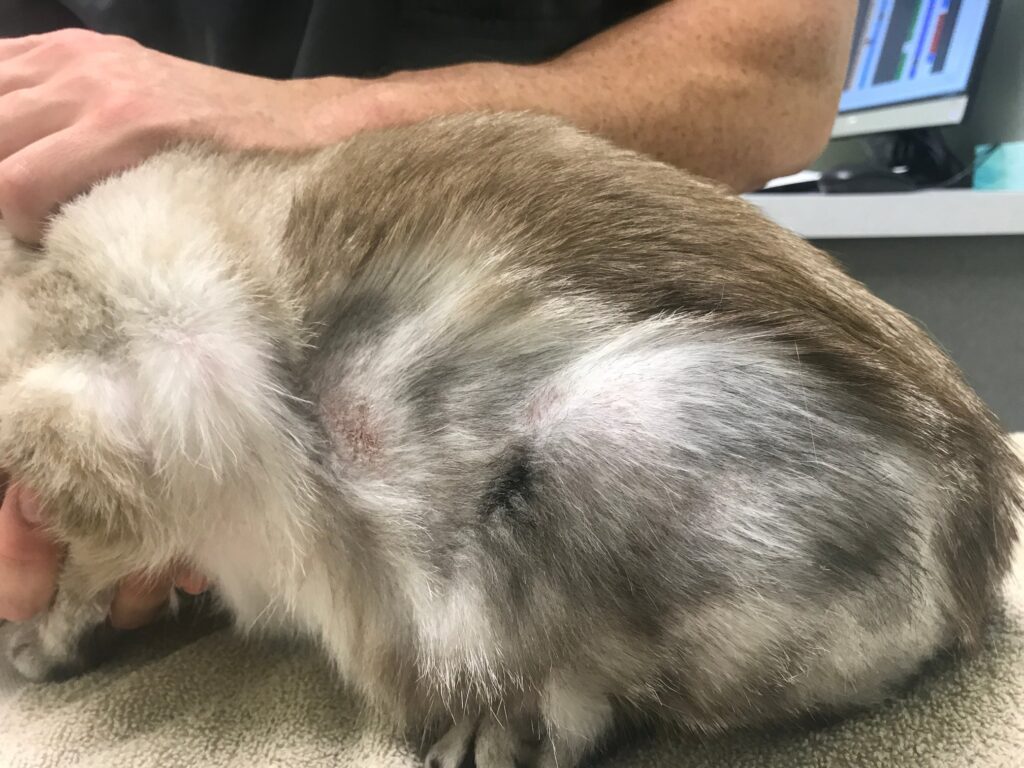Flea saliva allergy in dogs and cats: symptoms, diagnosis and therapy
introduction
Flea saliva allergy is a common allergic reaction in dogs and cats. This allergy is also known as flea allergy or medically as “allergic flea salivary dermatitis (FAD)”. In this article you will learn more about the symptoms, diagnosis and treatment of this allergy.
Symptoms of flea saliva allergy
A key symptom of flea saliva allergy is severe itching, which causes dogs and cats to scratch themselves intensively. The itching is often limited to the back half of the body. Typical parts of the body where a flea saliva allergy manifests itself are:
- The hip area
- The base of the tail
- The upper tail area
- The ischium
- The thighs
- The flanks
- The back area of the back



(C) https://www.animaldermatology.com/services/flea-flea-allergy
Sometimes symptoms of flea allergy also appear in the abdominal or genital area. In cats, flea allergy can also appear on the head and neck and cause miliary dermatitis and eosinophilic granuloma complex symptoms.
Diagnosis of flea allergy
Diagnosing allergic flea saliva dermatitis is not easy. There are allergy tests for fleas, but these tests can also give false negative results. The best way to diagnose allergic flea salivary dermatitis is by typical appropriate clinical symptoms and response to therapy.
This diagram illustrates the process from the suspected diagnosis through the testing phase to the final confirmation or alternative diagnosis and treatment. It emphasizes the importance of flea control as the first step in relieving symptoms and confirming the diagnosis. Subsequent steps include evaluation and treatment of other possible allergies or skin diseases if the animal's condition does not improve.
This is how the flea infestation test is done:
Flea testing is an important step in examining dogs and cats that exhibit symptoms of flea allergy. Here are the exact steps to perform this test:
- Visual Inspection : The first step is to visually inspect the animal. Flea infestations can sometimes be detected by the naked eye, especially in heavy infestations. Flea feces may also be noticeable upon visual inspection, appearing as small black crumbs in the animal's fur.
- Using a flea comb : A special flea comb with narrow teeth is used to thoroughly comb the animal's fur. Particular attention should be paid to the areas around the hind legs, the stomach and the base of the tail, as these are preferred locations for fleas. Any fleas or flea feces found can be collected in this way.
- Flea poop test : Black crumbs found can be tested for flea poop. To do this, place the crumbs on a damp, white cloth or paper. If they turn red or rusty brown, it is flea excrement because it contains the blood pigment hemoglobin.
- Conducting additional testing : If no direct evidence of a flea infestation is found, but a flea allergy is suspected, additional testing may be performed. This may include, for example, an intradermal allergy test, in which the animal is tested for a range of allergens, including flea antigen.
It is important to note that the absence of fleas on examination does not necessarily mean that the animal is not infested with fleas or that fleas are not the cause of the symptoms. Fleas spend only a small part of their life cycle on the host animal, and an animal can have an allergic reaction to the bites of fleas even if no fleas are found on the animal at a given time. Therefore, a thorough examination and perhaps further testing is necessary if flea allergy is suspected.
Treatment of flea allergy
The treatment of flea saliva allergy includes:
- Flea prevention: Dogs and cats with a flea saliva allergy should receive flea prevention year-round. Most preparations that are used for an acute flea infestation also offer further prophylaxis over several weeks.
- Treating Secondary Infections: Some dogs and cats develop scabs that indicate secondary bacterial infections. These secondary infections also need to be treated.
Flea prevention and flea control
To combat fleas in dogs and cats, adulticidal preparations are usually used, either in tablet form or as a spot-on. These flea adulticides kill the adult flea, which transmits the saliva allergen through its bite. The speed at which the fleas are killed plays an important role; this is called “speed to kill” (STK). Basically you can say that the faster the fleas are killed, the better.
Treatment and prevention of flea allergy
Preventive Measures for Flea Control
In order to effectively prevent flea allergies in dogs and cats, year-round flea prevention is essential. Regular use of flea preventatives recommended by your veterinarian can reduce the risk of flea infestations and allergic reactions.
In addition, it is important to keep the animal's environment clean. Regular vacuuming and washing pet beds, blankets and pillows can help reduce the risk of flea infestation. Pet owners should also check their pets regularly for fleas and take immediate action if they suspect a flea infestation.
Treatment of flea allergy
Treating flea allergy in dogs and cats involves several steps to relieve allergy symptoms and eliminate the cause of the problem - fleas. Here are the main treatment steps:
- Eliminating the Fleas : As previously mentioned, the first step in treatment is eliminating the fleas. The vet can prescribe suitable flea control products, such as: E.g. spot-on preparations, tablets or collars. The treatment should be used on all pets in the household to prevent reinfestation.
- Treatment of skin inflammation : If the skin is severely irritated and inflamed, the veterinarian may prescribe ointments or tablets containing corticosteroids to relieve the itching and inflammation. In some cases, antibiotic therapy may also be necessary to treat secondary bacterial infections.
- Symptomatic treatment : Additional measures may be taken to relieve symptoms, such as: B. cooling compresses, hypoallergenic shampoos or anti-inflammatory medications.
- Boosting the immune system : A healthy immune system can help better manage allergic reactions. Therefore, it is advisable to ensure a balanced diet and sufficient exercise to strengthen your animal's immune system.
Summary
Flea allergy is a common allergic reaction in dogs and cats that is often underestimated and difficult to diagnose. Early detection and treatment as well as consistent flea prevention are crucial to alleviating the suffering of affected animals and ensuring successful treatment. Pet owners should work closely with their veterinarian to develop the best approach to treating and preventing flea saliva allergy in their pets.
Long-term management strategies
Successful treatment and prevention of flea allergy requires long-term care and monitoring of the affected animal. Here are some long-term management strategies pet owners should consider:
- Regular check-ups : It is important that pet owners schedule regular check-ups with their veterinarian to monitor their pet's condition and detect any changes in symptoms in a timely manner. This allows treatment to be adjusted quickly and helps reduce the risk of complications.
- Environmental control : Careful control of the animal's environment can help reduce the risk of flea reinfestation and therefore the risk of an allergic reaction. This includes regularly vacuuming carpets, upholstered furniture, and mattresses, and washing pet beds and blankets in hot water.
- Allergy management : In some cases, the veterinarian may also recommend allergy management tailored to the animal's individual needs. This may include, for example, using hypoallergenic feed, avoiding certain environmental allergens or using immunotherapy.
- Education and support : Pet owners should educate themselves about flea saliva allergy and its potential impact on their pet's health and well-being. Open communication and collaboration with the veterinarian is crucial to ensuring the best possible care for the affected animal.
Frequently asked questions about flea allergies in dogs and cats:
What are the most common symptoms of flea allergy in dogs and cats?
The most common symptoms of flea saliva allergy in dogs and cats are intense itching, skin redness, swelling, hair loss, and weeping or crusting skin lesions. These symptoms usually occur in areas where fleas prefer to reside, such as the back, base of the tail, and hind legs. In severe cases, secondary infections caused by bacteria or yeasts can develop, leading to worsening skin symptoms and increased suffering for the affected animal.
How is flea saliva allergy diagnosed in pets?
Diagnosis of flea saliva allergy is based primarily on history, clinical symptoms, and response to treatment. The veterinarian will conduct a thorough examination of the animal to identify possible flea bites and associated skin reactions. Complete flea control is an important part of the diagnosis, as improvement in symptoms after successful flea treatment can be an indication of a flea saliva allergy. In some cases, the vet may also perform skin tests or blood tests to confirm allergy to flea saliva or other allergens.
What preventative measures can pet owners take to reduce the risk of flea saliva allergy in their pets?
To reduce the risk of flea saliva allergy in pets, regular and consistent flea prevention is crucial. Pet owners should treat both their pets and the environment for fleas. This includes using flea preventatives recommended by the veterinarian, such as topical solutions, oral medications, or collars. Additionally, pet owners should regularly check their pets for fleas and flea feces and take immediate action if necessary. Environmental control, such as regularly vacuuming carpets, upholstered furniture, and mattresses, and washing pet beds and blankets in hot water, can help reduce the risk of flea reinfestation.
Conclusion
Flea saliva allergy represents a serious health challenge for dogs and cats. Early diagnosis, adequate treatment and regular preventative measures are essential to alleviate the suffering of affected animals and maintain their quality of life. Close collaboration between pet owners and veterinarians is crucial to ensure the best possible treatment and care for pets with flea saliva allergies. By following the above recommendations and long-term management strategies, pet owners can help minimize the risk of flea infestations and allergic reactions in their pets, thereby promoting their health and well-being.
Current literature on flea allergy in dogs and cats:
Below you will find a selection of current and important literature on the subject of "flea allergy in dogs and cats":
- "Flea allergy dermatitis in dogs and cats: pathogenesis, diagnosis and treatment" by Dr. Ralf S. Mueller and Dr. Manfred Rohrer (2023): This comprehensive guide for veterinarians discusses the latest findings on the pathogenesis, diagnosis and treatment of flea allergy dermatitis in dogs and cats.
- "Current Advances in the Treatment of Flea Allergy Dermatitis in Pets" by Dr. Rosanna Marsella and Dr. Claudia Nett-Mettler in the Journal of Veterinary Dermatology (2022): This article provides an in-depth analysis of recent advances in the treatment of flea allergy dermatitis.
- “Diagnosis and Management of Flea Allergy Dermatitis in Dogs and Cats” by Dr. Thierry Olivry in the Journal of Small Animal Medicine (2023): This article provides practical advice and guidance for the diagnosis and treatment of flea allergy dermatitis, based on the latest research.
- "Flea Allergy Dermatitis: Current Research and Future Perspectives" by Dr. Karen Moriello and Dr. Catherine Outerbridge in the Journal of Veterinary Science (2023): This article provides an overview of current research in the area of flea allergy dermatitis and discusses potential future research directions.
- "Practical Approaches to Prevention and Control of Flea Allergy Dermatitis in Dogs and Cats" by Dr. Michael Dryden in the Journal of Animal Health and Prevention (2022): This article provides practical tips and advice for pet owners on preventing and controlling flea allergy dermatitis.
Please note that despite the continued advances in research into flea allergy dermatitis, the importance of prevention and early diagnosis cannot be underestimated. Veterinarians and pet owners should therefore regularly inform themselves about the latest research and treatment guidelines.
